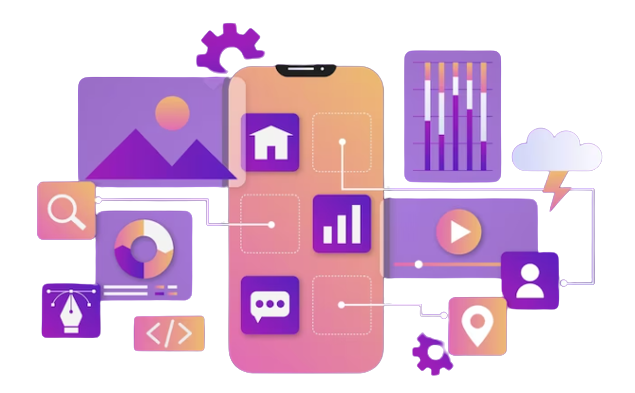The integration of IoT into mobile apps represents a paradigm shift in the way we interact with technology and the world around us. It brings forth unprecedented convenience, personalization, and efficiency in our daily lives. As IoT continues to evolve, we can expect even more innovative applications and a deeper level of connectivity in our mobile experiences.
The digital era has ushered in a wave of technological innovation that continues to shape our lives in profound ways. One such innovation that has gained significant traction is the Internet of Things (IoT). IoT refers to the network of interconnected devices and objects that collect and exchange data, creating a seamless and intelligent environment. While IoT has applications across various domains, its integration into mobile apps has opened up a world of possibilities, transforming the way we interact with our devices and surroundings. In this blog post, we’ll explore the exciting realm of IoT integration in mobile apps and how it is reshaping the way we experience connectivity.
The IoT Revolution: A Quick Overview
Before we delve into the impact of IoT integration in mobile apps, let’s take a moment to understand the essence of the IoT revolution. IoT encompasses a vast ecosystem of devices, sensors, and objects, ranging from smart thermostats and wearables to industrial machinery and autonomous vehicles. These devices are equipped with sensors and connectivity capabilities, enabling them to collect and transmit data to other devices or centralized systems.

IoT thrives on the concept of interconnectedness and data sharing, and it has given rise to innovative solutions in various industries, including healthcare, agriculture, transportation, and smart homes. However, one of the most exciting frontiers of IoT lies in its integration into mobile applications.
IoT Integration in Mobile Apps: The Essentials
-
Seamless Device Control
Imagine being able to control your home’s lighting, thermostat, and security system from a single mobile app, even when you’re miles away. IoT integration in mobile apps makes this a reality. Users can remotely interact with IoT-enabled devices, adjusting settings, monitoring statuses, and receiving real-time updates—all from the palm of their hand.
For example, smart home apps allow homeowners to adjust their thermostat settings on a hot summer day or check if all doors are locked and secure, providing convenience, energy savings, and peace of mind.
-
Enhanced User Experiences
IoT-powered mobile apps create enhanced user experiences by leveraging data from interconnected devices. Whether it’s fitness trackers providing personalized health insights or smart cars offering real-time traffic updates and maintenance alerts, IoT integration enhances the functionality and value of mobile applications.
-
Data-Driven Insights
IoT generates an enormous amount of data. Mobile apps integrated with IoT devices can tap into this data to provide valuable insights. For instance, agricultural apps can use IoT data to optimize irrigation schedules for crops, while healthcare apps can use wearable device data to track patients’ health conditions.
Real-world examples of IoT Integration in Mobile Apps
To better illustrate the impact of IoT integration, let’s explore some real-world examples:
-
Smart Home Control Apps
Apps like Google Home and Apple HomeKit allow users to control a wide range of IoT devices within their homes, including lights, thermostats, doorbells, and security cameras. Users can create custom routines, such as “movie night” or “morning wake-up,” that trigger multiple devices simultaneously.
-
Healthcare and Fitness Apps
Wearable fitness trackers, such as Fitbit and Apple Watch, collect data on users’ physical activity, heart rate, and sleep patterns. Mobile apps associated with these devices provide users with insights, goal tracking, and health recommendations.
-
Smart City Apps
Many cities are embracing IoT to improve urban living. Mobile apps for smart cities offer features like real-time public transportation updates, parking availability, and air quality monitoring. These apps enhance the quality of life for residents and visitors alike.
Benefits of IoT Integration in Mobile Apps
-
Convenience
IoT integration in mobile apps simplifies everyday tasks by providing centralized control and real-time updates. Users can remotely manage devices and receive alerts, making life more convenient and efficient.
-
Personalization
IoT data allows for highly personalized experiences. Mobile apps can use this data to tailor content, recommendations, and settings to individual user preferences, enhancing user satisfaction.
-
Efficiency
Incorporating IoT into mobile apps can lead to increased efficiency in various domains, such as energy management, healthcare monitoring, and industrial operations. Businesses can optimize processes, reduce waste, and improve resource allocation.
Challenges and Considerations
While the integration of IoT into mobile apps offers immense potential, it also comes with challenges:
-
Security Concerns
IoT devices are susceptible to security breaches. Mobile apps must prioritize robust security measures to protect user data and prevent unauthorized access to IoT devices.
-
Data Privacy
Collecting and sharing data from IoT devices can raise privacy concerns. Mobile apps should adhere to data protection regulations and obtain user consent for data collection and sharing.
-
Compatibility
IoT encompasses a wide array of devices with different communication protocols. Ensuring compatibility and seamless integration with various IoT devices can be complex.
Conclusion
The integration of IoT into mobile apps represents a paradigm shift in the way we interact with technology and the world around us. It brings unprecedented convenience, personalization, and efficiency in our daily lives. As IoT continues to evolve, we can expect even more innovative applications. And a deeper level of connectivity in our mobile experiences.
Businesses and developers are keen on harnessing the power of IoT integration in mobile apps. Tanbits‘ comprehensive IOT services, should prioritize user security, data privacy, and compatibility with a diverse range of IoT devices. By doing so, they can unlock the full potential of IoT, creating connected experiences that enhance the way we live, work, and play in this ever-connected world.
BACK










